Physical Address
304 North Cardinal St.
Dorchester Center, MA 02124
Plant dermatitis
Plant dermatitis may be produced by different plant species.
It is increasing in incidence worldwide.
It may be classified as mechanical injury, primary irritant (toxic) dermatitis, allergic phytodermatitis, and contact urticaria.
Acute cases present as linear urticarial, erythematous, and blistering lesions that may leave hyperpigmented macules.
Chronic cases present as lichenified, scaling dermatitis.
Diagnosis includes a history and physical examination, identification of plant species, and patch testing.
Treatment is symptomatic, including wet soaks, topical steroids, and antihistamines. More severe cases need systemic steroids.
Plant dermatitis or phytodermatitis is a skin eruption produced by different plant species. It has been known to humans since it was first recorded by ancient farmers, such as the Assyrians, 4000 years ago. Trees, flowers, grasses, vegetables, fruits, weeds, and air-borne pollens may produce it. However, those plants known to cause phytodermatitis belong to just a few families, and plant sensitizers belong to closely related chemicals. Plant dermatitis is more common in hot climates, not only because of greater exposure as less clothes are worn, but also because hot-climate plants seem to have a wider variety of chemicals.
Almost everyone is subject to exposure to plants every day, whether to plants at work or to food or ornamental plants at home. Exposure at work represents an occupational dermatitis affecting mostly farmers, gardeners, carpenters, florists, and field workers. There has been an increasing number of cases of plant dermatitis as more and more plant-derived products are used in health care and beauty. Although some plant families have worldwide distribution, many have been reported only in tropical and subtropical areas, and this should be considered when dealing with individuals who have been in these areas. The reaction may be classified, in accordance with its mechanism, as mechanical (including pharmacologic) injury, primary irritant (toxic) dermatitis, allergic phytodermatitis, or contact urticaria.
Many plants possess hairs, spines, or thorns that are designed to prevent predation, or to deflect water. In this case, the lesions are produced directly by parts present on the surface of the plant (e.g., palms, cacti, grasses, and cereals, etc.). In addition to the injuries caused by their spines, cacti may contain structures called glochids that may produce allergic or granulomatous reactions. Opuntia ficus indica , the prickly pear or sabra of the USA, Mexico, and the Mediterranean region, causes dermatitis through its glochids. Some families and genera of plants that have been reported to cause mechanical injury in tropical areas are shown in Table 36-1 .
| Family | Example | Type of Reaction | Distribution |
|---|---|---|---|
| Acanthaceae | Acanthus | M | Tropics and Mediterranean |
| Actinidiaceae | Actinidia chinensis Planchon (Kiwi fruit) | A / I / U | Tropical regions of eastern Asia, northern |
| Australia, and the USA | |||
| Agavaceae | Agave americana L. (American aloe) | A / I / M | Tropics and subtropics |
| Alangiaceae | A / M | Tropical Africa and Asia | |
| Alliaceae | Allium sativum L . (garlic) and A. cepa L . (onion) | A / I | Worldwide |
| Alstroemeriaceae | Alstroemeria L. (Peruvian lily) | A | Central and South America |
| Amaranthaceae | Amaranth | A / M | Tropical and temperate regions |
| Amaryllidaceae | Amaryllis | I | Tropics and subtropics |
| Anacardiaceae | Anacardium occidentale L. (cashew-nut tree), | ||
| Lithraea brasiliensis (aroeira), and Mangifera indica L. (mango) | A | Tropical and warm temperate regions | |
| Annonaceae | Annona spp. (custard apple, graviola, sugar apple) | I | Tropical USA |
| Apocynaceae | Aspidosperma spp. | A / I / M | Tropics |
| Araceae | Philodendron spp. and Dieffenbachia spp. | I | Tropics |
| Araliaceae | Panax ginseng C. Meyer (ginseng) | A | Tropical regions, particularly in Indo-Malaysia and tropical USA |
| Araucariaceae | Araucaria angustifolia Kuntze (Brazilian pine) | A / M | Southern hemisphere |
| Asteraceae (formerly Compositae) | Parthenium hysterophorus L. (feverfew, carrot weed) and some species of Ambrosia | A | Worldwide |
| Balanitaceae | Balanites aegyptica Del. (desert date) | M / P | Tropical Africa to Myanmar |
| Bignoniaceae | Jacaranda brasiliana Pers. (jacaranda) | A / I | Tropics |
| Bombacaceae | Adansonia digitata L. (baobab, sour gourd) | M | Tropical areas, especially in Americas |
| Bromeliaceae | Ananas comosus Merrill (pineapple) | I / M | Tropical USA and the West Indies |
| Cactaceae | Opuntia ficus-indica Miller (Indian fig cactus, common sabra) | M | Arid regions of Americas |
| Cannabaceae | Cannabis sativa L. (marijuana) | A | Tropical and temperate regions |
| Caricaceae | Carica papaya L. (papaya) | I | Tropical regions of USA and Africa |
| Cecropiaceae | Cecropia loefl. (trumpet tree) | I | Tropical USA |
| Cleomaceae | Cleome L. spp. (spider plant) | I | Tropics and subtropics |
| Crypteroniaceae | Dactylocladus stenostachya Oliver (jongkong, medang tabak) | I | Tropical Asia |
| Cucurbitaceae | Gourds, squashes, pumpkins and cucumbers | I | Tropics |
| Dilleniaceae | Davilla rugosa Poiret (fire vine) | I | Tropics and subtropics |
| Dioscoreaceae | Dioscorea spp. | I | Tropical and warm temperate regions |
| Ehretiaceae | Cordia goeldiana Huber (Brazilian walnut) | A | Tropics and subtropics |
| Erythroxylaceae | Erythroxylum coca Lam. (cocaine) | I | Tropics |
| Euphorbiaceae | Hevea brasiliensis Muell. Arg. (rubber) | A / I / M | Worldwide |
| Ginkgoaceae | Ginkgo biloba | A | Widely cultivated and perhaps found wild in eastern China |
| Graminae | Most food grains such as rice, oat, corn, and wheat | A / I / M / U | Worldwide |
| Iridaceae | Iris spp. | A / I | Southern Africa and tropical USA |
| Jubulaceae | Frullania spp. (liverworts) | A | Tropics and subtropics |
| Lecythidaceae | Bertholletia excelsa (Brazil-nut tree) | A | Tropical USA |
| Leguminosae | Dalbergia nigra (Brazilian rosewood) and Mucuna pruriens (buffalo bean) | I | Worldwide |
| Liliaceae | Aloe spp., Asparagus spp. | A | Worldwide |
| Lythraceae | Lawsonia inermis (henna tree) | I / U | Worldwide |
| Malvaceae | Gossypium hirsutum (cotton) | A / PP | Tropics and subtropics |
| Meliaceae | Khaya spp. (African mahogany) | A | Warm regions |
| Moraceae | Ficus carica (fig) | A / P | Tropics and subtropics |
| Palmae or Arecaceae | Cocos nucifera L. (coconut), Copernicia cerifera (wax palm, carnauba palm) | I | Tropics and subtropics |
| Rutaceae | Citrus limon (lemon) | P | Tropics and temperate regions |
| Solanaceae | Capsicum annuum (cayenne pepper, paprika, chilli, tabasco) | I | Central and South America |
| Urticaceae | Urtica spp. (nettle) | U | Tropical and temperate regions |
| Zingiberaceae | Zingiber officinalis (ginger) | I | Tropical regions, especially Indo-Malaysia |
The wound may be complicated by secondary infection, either bacterial or fungal, such as sporotrichosis. Thorns and spines penetrating the skin near joints may cause septic arthritis and when near bone may mimic bone tumors. Pharmacologic injury is the term used for lesions produced by some plant species, especially from the Urticaceae family, that contain glandular hairs inoculate pharmacologically active substances such as histamine, acetylcholine ,and 5-hydroxytryptamine, producing mechanical effects enhanced by the substance reaction.
Substances produced by the plant cause primary irritant (toxic) and allergic contact dermatitis. Commonly, the substance responsible for the dermatitis is a secondary product not participating directly in the plant metabolism. The distribution of the substance in the plant is important for the occurrence of the reaction. It may be present on the surface of the plant, and a simple or casual contact may be sufficient to cause dermatitis, or it may be situated deeper in the plant structure or in its root, and in this case the plant needs to be crushed in order to produce the disease. Equally important is the relative quantity of these substances, and this depends on different factors such as stage of maturity, hydration level, soil type, and climatic conditions.
Primary irritant contact dermatitis is produced by direct chemical irritation, without an allergic mechanism. Everyone who is exposed is expected to react, unless the degree of exposure, including concentration of the chemical and duration of contact, is insufficient. Irritation is caused by chemicals present in the plant such as proteolytic enzyme (i.e., Bromeliaceae family); oxalic, formic and acetic acids; glycosides; isothiocyanates; and crystals of calcium oxalate. Mucuna pruriens , also known as itch plant, produces a proteolytic enzyme named mucunine, which is used by practical jokers as the major ingredient of “itching powder.” Pineapple ( Ananas comosus ) , which contains calcium oxalate and a proteolytic enzyme called bromelin, is a common cause of occupational phytodermatitis in less-developed tropical countries, where workers contract hand dermatitis as a result of fruit juice handling. Dieffenbachia and Philodendron are genera of tropical plants of Central and South America that produce irritant dermatitis by bundles of needle-like calcium oxalate known as raphides. Some families and genera of plants that have been reported to cause primary irritant contact dermatitis in tropical areas are shown in Table 36-1 .
First described in 1942 by Klaber, phytophotodermatitis is a very common skin disease within the irritant contact dermatitis group. It consists of an acute phototoxic reaction, usually caused by contact with substances known as furocoumarins (5-methoxypsoralen, limettin, isopimpinellin, bergapten, and xanthotoxin) followed by sun exposure, specifically in the ultraviolet A (UVA) range, which is 320–400 nm. Many cases are occupational in nature, but nowadays this disorder is becoming more widespread as more people apply to their skin products varying from home remedies to trademark preparations that contain photosensitizing agents. In the tropics, these substances have mostly been found in plants of the Rutaceae and Moraceae families. Citrus fruits such as lime ( Citrus aurantifolia ), lemon ( C. limon ) ( Fig. 36-1 ), and grapefruit ( C. paradisi ) of the Rutaceae family and fig ( Ficus carica ) of the Moraceae family are commonly occurring plants that contain these photosensitizing substances. Furocoumarins in lime pulp are 13–182 times less concentrated than those in the peel. Berloque dermatitis results from the application of perfumes or colognes containing oil of bergamot, which comprises 5-methoxypsoralen. R. graveolens , an herb commonly known as rue and also from the Rutaceae family, has long been used for its various medicinal properties, as an antiinflammatory and analgesic in treating systemic infections, eczema, external ulcers, rheumatism, and cramps, and as an insect repellent. R. graveolens contains numerous chemicals, including essential oils, furocoumarins (e.g., bergapten, psoralen, and imperatorin), carotenoids, chlorophyll, and antimicrobial alkaloids called furoquinolines.
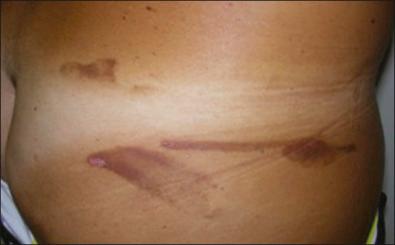
The fig, a member of the Moraceae family, has been described as an important causative agent of burns and bullous dermatitis during the summer months in countries of the Middle East and Mediterranean, as well as tropical and subtropical areas of the USA. In Brazil, fig leaves have long been used as a tanning agent, resulting in several cases of phototoxic dermatitis being seen in dermatologic clinics ( Figs. 36-2 and 36-3 ).
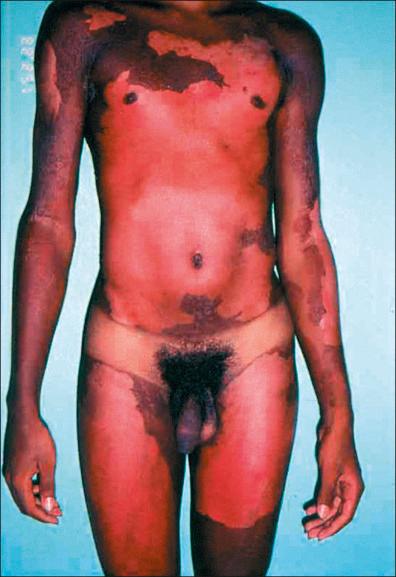
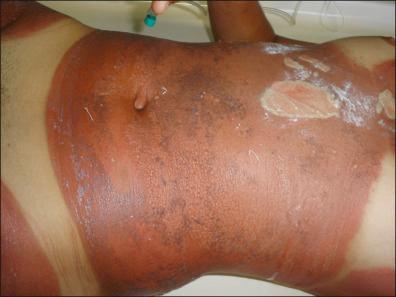
Sometimes the furocoumarin substance is produced not by the plant itself but, for example, by fungi infecting the plant; this is termed pseudophytophotodermatitis. Table 36-1 shows some families and genera reported to cause phytophotodermatitis in tropical areas.
Many cases fall into the group of allergic phytodermatitis, which is a type IV hypersensitivity reaction (delayed reaction). Previous contact with the plant or a phylogenetically correlated species must have occurred in order for the hypersensitivity to take place. The sensitization may occur within 7–10 days after the first contact with the plant, as well as several years after exposure. The sensitizing agent is usually present in the oleoresin fraction, which may be distributed throughout the plant and in the pollen. The oleoresin is a mixture of aldehydes, aromatic alcohols, terpenic compounds, aliphatic and aromatic esters, and phenols, including catechols, resorcinols, and hydroquinones.
In the Americas, the great majority of cases occurs after contact with plants of the Anacardiaceae family, which contains potent hydroxylated benzenes (catechols). The antigenic substance is the urushiol or 3- n -pentadecyl-catechol. Several genera may be found in tropical areas of South America, the most studied being the Lithraea spp. ( Fig. 36-4 ). Other members of the family include the cashew nut tree ( Anacardium occidentale ), mango ( Mangifera indica ), Brazilian pepper tree ( Schinus terebinthifolius ), Indian marking nut tree ( Semecarpus anacardium ), Japanese lacquer tree ( Toxicodendron verniciflua ), S. coriacea in the Indian subcontinent, Rhus verniciflua , and R. succedaneum in Australia and New Zealand.
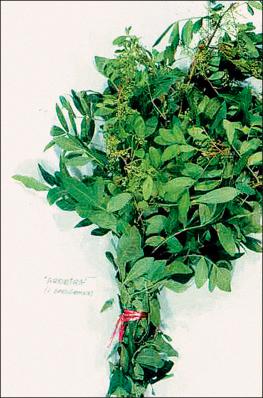
The ginkgo tree ( Ginkgo biloba ), which belongs to the Ginkoaceae family, also contains urushiol and is considered together with members of the Anacardiaceae family. In Brazil some reactions are due not only to working exposure, but also to their use in popular medicine. In these particular cases, aroeira ( Lithraeae brasiliensis ) is used most frequently, for wound care as well as in the treatment of ulcerative lesions in lower limbs ( Fig. 36-5 ), joint pain, diarrhea, and bronchitis. However, cross-reactivity may occur with substances produced by other members of the Anacardiaceae family, due to the structural similarity, including the Toxicodendron (formerly Rhus ) genus, which is quite common in the USA.
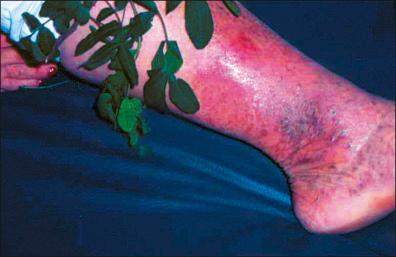
The Asteraceae (formerly Compositae) family includes some genera that may be found in tropical regions and in which the sensitizers are sesquiterpene lactones. Parthenium hysterophorus (carrot grass) was accidentally introduced in India, where it is now an important source of cases of allergic phytodermatitis, affecting up to 4% of the exposed population. The liverwort ( Frullania spp.) is responsible for reactions mostly in forest workers of tropical and subtropical regions. The antigen is also sesquiterpene lactones, which cross-react with substances produced by members of the Asteraceae family. Plants of the Philodendron genus, a member of the Araceae family, may cause allergic dermatitis; the sensitizer substances are resorcinols.
Balsam of Peru may cause allergic dermatitis, and shows cross-reactivity with perfumes containing cinnamon, orange, and other flavors. Exposure may occur as early in life as in baptismal procedures using chrism oil.
Fig trees contain a milky sap that may produce allergic dermatitis. In Africa, “bee glue” (propolis), which is used as wood and leather varnish, and as a base for ointments, cosmetics, and polishes, may produce allergic dermatitis.
An erythema-multiforme-like eruption from Brazilian rosewood ( Dalbergia nigra ) has been reported in a carpenter in whom a patch test with wood dust produced a positive reaction. Some families and genera of plants that have been reported to cause allergic phytodermatitis in tropical areas are shown in Table 36-1 .
This type of reaction may have two different mechanisms. Non-immune contact urticaria is an immunoglobulin E (IgE)-independent reaction, which may be induced by nettles, and plant extracts such as cinnamic aldehyde, cinnamic acid, and balsam of Peru. In contrast, allergic contact urticaria is an IgE-dependent reaction that may be produced by plant extracts such as natural rubber, which is derived from Hevea brasiliensis . Individuals sensitive to rubber may produce cross-reactions with banana and apple. Actinidia chinensis Planchon (kiwi fruit) has been reported to cause type I hypersensitivity in tropical areas of eastern Asia, northern Australia, and the USA.
Ingested plants may induce urticarial lesions and anaphylaxis, as occurs in individuals who are allergic to peanuts. Atopic patients are more prone to this kind of reaction.
Table 36-1 shows some families and genera reported to cause contact urticaria in tropical areas.
A detailed history is necessary to determine the likely source of exposure. It usually involves the hands, forearms, and face, including the eyelids. The perioral region is most affected in reactions caused by fruits, such as in dermatitis caused by mango. In mechanical lesions, the clinical manifestations depend on agent shape and injury mechanism. In lesions produced by the Indian fig ( Opuntia ficus indica ), glochids present on its surface penetrate the skin, and a tinea-corporis-like dermatitis is formed, sometimes with granuloma formation – a condition called sabra dermatitis. In pharmacologic dermatitis, the lesion assumes the characteristic physiologic changes of the active substance in the contact area.
In other cases, individuals present with acute urticarial, erythematous, and / or vesicobullous dermatitis. They usually present as linear or bizarre lesions, reflecting the contact with the plant ( Fig. 36-6 ). Chronic cases present as lichenified lesions and chronic fissuring or scaling dermatitis ( Fig. 36-7 ). Fissuring and hyperkeratosis of the fingertips and subungual hyperkeratosis may be the only manifestation; this is the case, for example, for lesions provoked by onion ( Allium cepa ) and garlic ( A. sativum ). The dermatitis may be that of a volatile pattern, such as in air-borne pollen dermatitis, with lesions involving mostly the exposed areas and resembling a light-aggravated dermatitis. Patients who developed an actinic chronic dermatitis following the acute phase of disease have been reported. Contact dermatitis from some wood-dust can resemble seborrheic dermatitis or neurodermatitis.
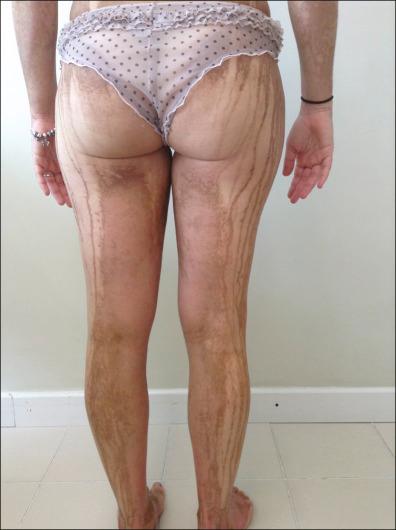
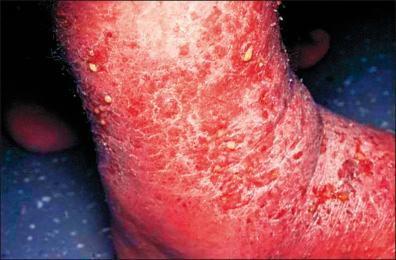
In phytophotodermatitis the clinical picture is that of sunburn, ranging from mild erythema to severe blistering at the site of exposure. Erythema typically develops within 24 hours and vesicles or bullae typically develop within 72 hours. Residual hyperpigmented, linear streaks represent the final stage; they occur over 1–2 weeks and can persist for 6–12 months. Stinging or burning sensations usually accompany the hyperpigmentation. Individuals of skin types IV–VI may present with just hyperpigmentation without any previous signs or symptoms of acute dermatitis.
In photoallergic contact dermatitis the clinical features are those of an allergic contact dermatitis that is aggravated by sun exposure and occurs especially in sun-exposed areas.
The diagnosis may not be evident when the patient does not present with the typical manifestations. Therefore, a history of working and leisure exposure to tropical plants or plant derivatives such as herbal remedies, spices and foods, woods, and fragrances is important in the diagnosis of phytodermatitis. When suspected, samples of the contacting plant, if available, should be obtained and brought to the physician. This sample should be divided into three parts. One part is used to identify the plant; this may be carried out by an expert botanist. The other parts are used for patch testing and for additional chemical studies. Plant dermatitis can be irritant, allergic, or pseudophytophotodermatitis. Patch testing is the only scientific method at present to detect the cause of contact dermatitis and usually the leaves are used, though it is preferable to test with standard concentrations of plant extracts. The first patch test should be limited to the group of plant families usually reported to cause plant dermatitis, in order to prevent unnecessary patch testing with popular but innocuous plants. If this is negative, subsequent testing may be necessary for diagnosis. Testing with known irritant plants should be avoided. When testing an unknown plant, several control volunteers are necessary so as to assess the value of a positive patch testing. The leaves are usually used for patch testing; however, sometimes the antigen is located in a different organ of the plant, in which case this plant part should be used for testing. In the setting of a photoallergic contact dermatitis, photopatch testing is an important tool to confirm the diagnosis.
Histologic examination shows an upper dermal perivascular infiltrate rich in eosinophils and lymphocytes, lymphocytic exocytosis, and epidermal spongiosis ( Fig. 36-8 ).
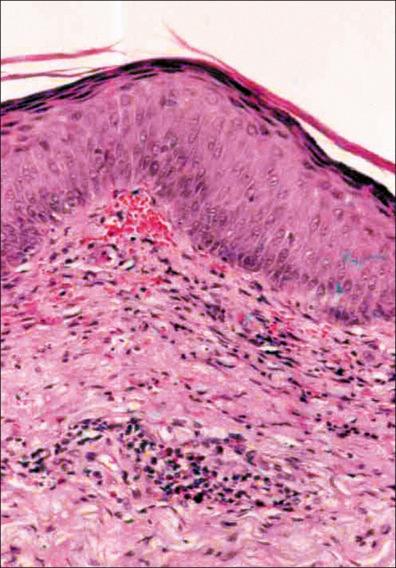
The occurrence of cross-sensitization is a real problem; however, true cases are uncommon and most cases represent false cross-sensitivity. This may occur when the same sensitizing chemical is present in two or more plant species.
In some cases the dermatitis may have not been produced by the plant itself, but instead herbicides, pesticides, fungicides, or fungi and arthropods infesting the plant may be the source of antigen. This condition is called pseudophytodermatitis. Appropriate history and physical examination, and allergic testing, should exclude other contact dermatitis and acute localized blistering diseases.
Treatment involves avoidance and a symptomatic approach. Avoidance of further contact with the allergen remains the cornerstone of management. If phytophototoxicity is suspected before the appearance of the skin changes, soap and water should be used to wash off the plant chemical from the area of contact; thereafter, application of sunscreen and abstention from sun exposure are strongly encouraged for the following 48 hours. Acute dermatitis is treated with wet soaks and soothing creams. Topical steroids in a cream base may be tried to alleviate the burning and stinging sensation, but do not seem to alter the course of the disease. Oral antihistamines may help stop the pruritus. Severe cases require systemic steroids. Chronic and subacute cases should be treated with topical steroids in an ointment base and oral antihistamines. For hyperpigmentation following phytophotodermatitis, sunscreens may be of help and may be used as a prophylactic measure for individuals at high risk. Resistant cases and patients who develop chronic actinic dermatitis may need to use azathioprine, cyclosporin (ciclosporin), and psoralens and long-wave ultraviolet light (PUVA). Hyposensitization can be tried when reexposure cannot be avoided, but is difficult to achieve.
Individuals should avoid contact with plants known to cause the dermatitis. Clothes and gloves do not always give complete protection. Workers with occupational dermatitis may stop working with one variety of plant, or change to a job that does not involve contact with the allergen. A new topical product containing quaternium-18 bentonite, called Ivy Block, which interferes with cutaneous absorption of urushiol, is available in the USA for the prevention of poison-ivy dermatitis. This product may also be useful for dermatitis caused by other members of the Anacardiacae family. The dermatitis may persist or recur owing to contact with cross-reacting chemicals present in other products, or as a result of unwitting contact with the allergen.
Tropical arthropods carry bacterial, protozoan and helminthic pathogens.
Mosquitoes are the most important group of vectors.
Preventive strategies include repellents, insecticides, bed nets, and infrastructure improvement.
In tropical regions, arthropod vectors are responsible for huge numbers of deaths each year. Malaria remains a major cause of death in much of the world, and has been reintroduced into areas of the United States. Interventions such as insecticide-treated bed nets are critical to reduce the high death rate, especially in the first year of life.
Yellow fever, transmitted by Aedes aegypti mosquitoes, caused epidemics in American cities during the 17th, 18th, and 19th centuries. In the 20th and 21st centuries, it has been found mostly in tropical regions. The eradication of yellow fever from Cuba and Panama in the early part of the 20th century was accomplished by means of vector control. One central principle in these eradication programs was the elimination of standing water where mosquitoes could breed.
Buruli ulcer is the third most common mycobacterial disease in humans, surpassed in frequency only by tuberculosis and leprosy. The causative bacterium is found in stagnant water, especially in rural areas where deforestation has led to flooding. Most patients are children who are infected either by direct inoculation through cuts and abrasions or via arthropod vectors. Implicated vectors include mosquitoes and aquatic creeping-water bugs (Naucordiae), which harbor the bacterium in their salivary glands.
Scrub typhus, carried by chigger mites, affects an estimated one million people each year. The causative organism, Orientia tsutsugamushi , is no longer classified within the genus Rickettsia . Severe systemic illness, including pneumonitis, can occur. Vector control is difficult, and control efforts center on personal protection.
Onchocerciasis (river blindness) is caused by Onchocerca volvulus and transmitted by black flies ( Simulium spp.), which breed in fast-flowing rivers. The disease has been endemic in tropical areas of Africa, Central America and South America, but a global eradication campaign (the Onchocerciasis Control Program) has reduced the burden of disease.
Not only does the vector spread the disease, but it may also influence the disease manifestations. When Bartonella organisms are transmitted by a flea, cat-scratch disease or bacillary angiomatosis occurs. In contrast, when they are transmitted by a louse, this is more likely to produce endocarditis.
Clinical features vary widely, depending on the disease that is transmitted. The bite itself may present as papular urticaria, but many bites are relatively asymptomatic. In tropical areas, individuals have high degrees of exposure to biting arthropods, and relative immune tolerance to the bites often occurs.
The initial bite or sting is characterized by a wedge-shaped perivascular lymphoid infiltrate with eosinophils. These features are highly variable, and those who show immune tolerance to the bite demonstrate little histologic reaction.
When traveling to malaria-endemic areas, mosquito netting, screening, protective clothing, repellents, and chemoprophylaxis are important components of an effective disease prevention strategy. The vast majority of American travelers who acquire malaria abroad have not complied with recommended steps for disease prevention, including the recommended chemoprophylactic drug regimen. In endemic areas, mosquito control programs have an excellent record of reducing the risk of mosquito-borne illness. Appropriate use of insecticides plays an important role in vector control, and has a favorable risk–benefit profile for those in the community. The importance of window screens and avoidance of arthropods when they are feeding should be stressed. Anopheline mosquitoes that carry malaria tend to bite at night, whereas Culex mosquitoes tend to bite during the day. Prevention programs must consider the feeding habits of important disease vectors in the area.
Protective long-sleeved lightweight clothing can be treated with permethrin to provide a measure of protection against both crawling and flying arthropods. Permethrin is also used to treat screens and mosquito netting. Treated clothing can be combined with the use of a repellent to minimize the risk of disease. DEET ( N , N -diethyl-3-methylbenzamide, previously called N , N -diethyl- m -toluamide) is effective against a wide range of arthropods. It can be applied to skin and clothing. Newer agents suitable for application to skin include IR3535, KBR 3023, and p -menthane-3,8-diol (PMD, menthoglycol). Permethrin is largely used for fabric impregnation and is stable through several wash cycles.
Consistent use of the repellent as well as other personal protective measures is essential while in a disease-endemic area. The American Academy of Pediatrics recommends concentrations of 10% or less in products intended for use in children. As many such products are available, it seems prudent to adhere to these guidelines in most circumstances. Repeated applications of high concentrations of DEET have been associated with signs of toxic encephalopathy is some individuals. DEET can also occasionally produce erythematous or bullous irritant dermatitis. Extended-duration formulations reduce the need for repeated applications. Picaridin in concentrations of 9.3% picaridin or 19.2% picaridin compares favorably with 35% DEET gel, 20% controlled-release DEET, and 33% DEET in a polymer formulation (US Army Extended Duration Repellent).
Neem oil has been used effectively in areas endemic for malaria. Kerosene-burning lamps used to vaporize transfluthrin, a pyrethroid insecticide, can provide significant protection against Culex mosquitoes, and are useful during the pre-bedtime hours before mosquito nets are used. Citronella candles have limited efficacy.
Additional mosquito-control strategies include elimination of standing water, and stocking of ponds and water barrels with selected fish or turtles to consume mosquito larvae. For limited areas, mosquito traps are helpful for area control. Mosquitoes are attracted to the trap by carbon dioxide, light, heat, and chemical attractants. Although octenol is commonly employed, some mosquitoes respond best to combinations of attractants, and some Culex mosquitoes are repelled by octenol. Propane-powered units are the most versatile and are effective for control of mosquitoes in limited areas.
Mesostegmatid mites infest mammals and birds.
Mites are ubiquitous in the environment and many can cause dermatologic disease.
In tropical countries, scabies infestation is a common cause of refractory impetigo.
Mites infest rodents ( Fig. 36-9 ), wild birds, livestock, cheese, other produce, and grains. They are widespread in the environment, and humans are commonly affected. Some mites act as disease vectors. Scabies infestation is a common cause of impetigo in tropical climates. The impetigo typically is refractory to treatment until the scabies infestation is treated.
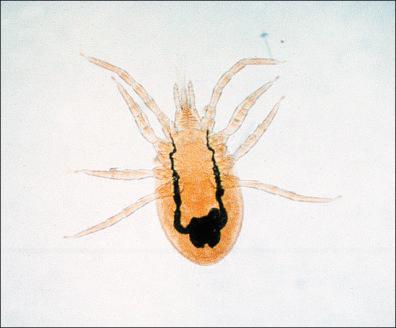
Eschars at the site of a bite suggest a rickettsial disease. Honey-crusted lesions of impetigo commonly obscure the burrows of scabies infestation in tropical climates. Cutaneous reactions include papular, papulovesicular, bullous, urticarial, and morbilliform eruptions. Secondary infection is common. Bullous eruptions may mimic bullous pemphigoid, even with positive immunofluorescent findings, and a high index of suspicion should be maintained.
Scrapings can identify scabies mites, and the burrows can become more apparent after application of India ink or gentian violet and cleaning with alcohol. Zoonotic mites can be treated with lactic acid or lactophenol to improve visibility of identifying structures. Hoyer's medium is used for mounting. A qualified acarologist can be of immense help with identification. To prepare the mounting medium, 30 g of gum Arabic is mixed with 50 ml of distilled water. Chloral hydrate (200 g) is then added, followed by 20 g of glycerin. The mixture is then filtered through cheesecloth.
Some mites remain attached to the skin, and scabies mites burrow. However, most mites simply “bite and run” on human skin, and the resulting hypersensitivity reaction is treated in a manner similar to other bites. Scabies mites are generally treated with topical agents such as permethrin, lindane, benzyl benzoate, and precipitated sulfur in petrolatum. Bird and bat roosts may have to be eliminated or treated with an insecticide. Some species are protected, which may complicate control efforts. Infested pets and livestock should be evaluated by a veterinarian. Personal protection with repellents and permethrin-treated clothing is important, especially for preventing infestation with a disease vector. Topical antipruritics containing camphor and menthol can be of immense value for symptomatic relief. Some topical anesthetics are potential contact allergens. Pramoxine has a low risk of contact allergy and is found in a wide variety of products. Class one topical corticosteroids are helpful for persistent cutaneous reactions. Intralesional triamcinolone may also be useful.
Trombiculid chigger mites are a common cause of mite-induced dermatitis in brushy areas. The larval, six-legged, mite is most commonly found attached to the host. The eight-legged, nymph and adult stages are found less commonly.
Chigger bites present as intensely pruritic grouped erythematous papules on the lower extremities ( Fig. 36-10 ), waistline and genitalia. Any areas of constricted clothing impede the progress of the mite and are common sites for bites. Genital lesions may be prominent, and may mimic scabies nodules. In children, dysuria may be a prominent symptom.
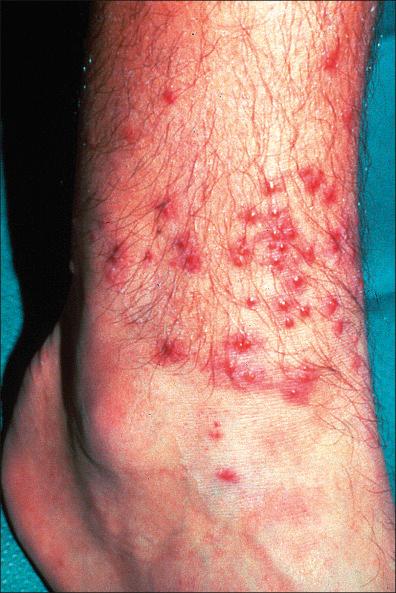
Potent topical corticosteroids are commonly needed, and may have to be occluded. As the lesions tend to be widespread and multiple, intralesional injection may be difficult, but may be the only successful intervention. Topical antipruritics and anesthetics may be helpful. Clothing impregnated with permethrin is very effective for prevention of chigger bites.
Ticks are disease vectors in all climates.
They cause devastating economic losses from death of cattle.
Some cause tick paralysis.
Amblyomma tick bites have been associated with development of red-meat allergy.
Ticks carry disease in tropical regions, just as they do in temperate zones. Rickettsial fevers are often associated with a black eschar at the site of the tick bite ( Fig. 36-11 ). Ornithodoros ticks carry borrelial relapsing fever in tropical regions, as they do in other parts of the world. Rhipicephalus (Boophilus) microplus transmits Anaplasma marginale and babesiosis. It is an important cause of economic losses for those dependent on cattle in the tropical areas of Central and South America. Aponomma hydrosauri is associated with Australian reptiles, and carries Rickettsia honei , the etiologic agent of Flinders Island spotted fever. In Australia, Ixodes holocyclus is an important cause of tick paralyisis. Ixodes rubicundus is the South African Karoo paralysis tick. Amblyomma tick bites have been associated with the development of allergic reactions to beef, pork, and lamb through the triggering of IgE antibodies to galactose-α-1,3-galactose, a carbohydrate present in red meat.
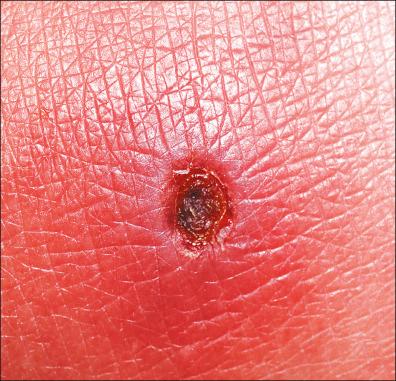
Prevention of tick infestation depends on a comprehensive program of environmental strategies and personal protection with permethrin-treated clothing and repellents. In many tropical areas, tick eradication programs have been successful and have reduced disease and economic losses. Methods to prevent tick infestations in dogs include monthly topical application of fipronil or permethrin, as well as collars impregnated with midacloprid / flumethrin or deltamethrin.
Spiders are widely distributed.
Bites may cause local necrosis or systemic symptoms.
Spider bites commonly produce necrotic skin reactions. Disseminated intravascular coagulation and neurotoxic effects may also be seen with some species. A wide variety of spiders produce local cutaneous reactions, and most are not well characterized. Brazilian Phoneutria nigriventer spiders (armed spiders) contain neurotoxins that produce cerebral changes and breakdown of the blood–brain barrier. Bites may be fatal in children.
Sparassid spiders are widely distributed in tropical climates.
Local effects tend to be self-limited.
Systemic symptoms are generally mild and transient.
Sparassid spiders occur in tropical regions worldwide; their bites tend to occur during the day in the warmer months of the year. These spiders are generally non-aggressive and must be provoked in order to bite. Pain, swelling, bleeding, and itching are common at the site of the bite. Systemic effects are usually mild, and include headache and nausea. Genera of medical importance include Isopeda , Isopedella , Neosparassus , Heteropoda , Delena , and Holconia .
Black and brown widow spiders are a problem in many tropical climates.
The females are large with a bulbous shiny round abdomen.
Systemic symptoms are secondary to a neurotoxin, and mimic an acute abdomen.
Severe tetany may be associated with rhabdomyolysis.
In general, black widow toxins are more potent than brown widow toxins.
Black widows are web-building spiders commonly found under outhouse seats, in woodpiles and in window wells. Latrodectus mactans , the common black widow, is distributed throughout North America and may be found in the Caribbean. L. curacavienis is native to South America, and L. indistinctus is found in Africa. The brown widow, L. geometricus , is native to southern Africa and Madagascar. Australia and New Zealand have related red-black spiders ( Latrodectus mactans hasselti ).
Latrotoxins are neurotoxins that produce uncontrolled nerve depolarization, increasing intracellular calcium and stimulating uncontrolled exocytosis and release of neurotransmitters.
As symptoms commonly mimic an acute surgical abdomen, unnecessary exploratory laparotomy may be performed. Tetany may be severe and prolonged, lasting for days.
Become a Clinical Tree membership for Full access and enjoy Unlimited articles
If you are a member. Log in here